Solopreneur Success Playbook: The Ultimate Guide to Building a Profitable One-Person Business with Digital Products
Step-by-step systems, tools, and strategies to help solopreneurs create, sell, and scale digital products for sustainable income.
Access your FREE Solopreneur Success Hub - your subscribers-only comprehensive command center for building and scaling a successful one-person business.
I created this all-in-one toolkit for building a profitable one-person business, something I wish existed when I first started, and it saves me 20+ hours a week.
Now, it’s yours. No Opt-In Required.
More information about the Hub here.
Skip the read, hit play.
Here’s the audio deep dive and visual presentation for the Solopreneur Success Playbook (created using Google NotebookLM)
Welcome to the Solopreneur Success Playbook
Ok, I need to say this first.
This isn’t a “quick tips” blog post.
It’s a full-on, step-by-step game plan to help you build a profitable one-person business around digital products.
It’s long. It’s detailed. And yes, it’s intentional.
Why?
Because most solopreneurs don’t fail from a lack of motivation. They fail from a lack of clarity.
This playbook was created to give you everything in one place.
The mindset, the systems, the tools, and the strategy. Nothing held back.
What You’ll Get Inside
To keep things easy to follow, I’ve structured this playbook into 6 core sections, each one building on the last:
→ Start with self-awareness, alignment, and clarity.
Create Scalable Digital Products
→ Turn your skills into courses, ebooks, SaaS tools, templates, or memberships.
→ Save time, scale output, and stop being the bottleneck in your business.
Understand the Audience Funnel
→ TOFU → MOFU → BOFU — attract, nurture, and convert.
→ Show up where your people actually are and post with purpose.
→ Refine what works, repurpose your best ideas, and repeat the process for growth that compounds.
You don’t need a team.
You don’t need a massive following.
You just need a clear plan and that’s exactly what this is.
So grab a coffee, bookmark this page, and dive in.
I personally believe that if you take action on even 30% of what’s inside, your business will never look the same again.
Let’s start building! 🚀
Section 1: Discover Your Core – The Power of Asking the Right Questions
Why Questions Come Before Hustle
Before you even think about launching that course, writing that ebook, or setting up your fancy landing page, slow down.
Building a business that actually lasts starts with clarity, not just action.
Solopreneurs often jump into tactics too quickly, when the real gold lies in taking clear action.
So, if you’re wondering why your growth feels stuck or inconsistent, maybe it’s because you haven’t asked the right questions yet.
Let’s fix that.
This section unpacks 7 transformative questions that shape your mission, product, strategy, and even your day-to-day joy as a creator or solopreneur.
1. What do I love doing that energizes me and excites me to get to work?
💡 Category: Passion | Focus Area: Personal Motivation
This is where your soul lives in your business.
If you’re not doing work that lights you up, it’ll eventually burn you out.
Simple as that.
Ask yourself:
What topics or tasks do I lose track of time doing?
If money weren’t an issue, what would I spend my time creating or helping people with?
This question focuses on finding the intersection of what feels good and what drives sustainable energy.
Try this:
List the top 5 moments in the last 30 days when you felt most energized at work. What were you doing? Who were you helping?
Why it matters:
If your business isn’t aligned with your passions, your content will feel forced, your products won’t sell with conviction, and your audience won’t connect with you deeply.
People feel authenticity, especially online.
2. What am I naturally good at or have developed strong skills in?
💡 Category: Talent | Focus Area: Skills & Expertise
Here’s the deal: You can’t teach or package something you’re shaky on.
But chances are, you’re way more skilled than you give yourself credit for.
Think about:
What do people often ask you for help with?
What tasks do you find easy that others find complicated?
What results have you helped others achieve?
Reality check:
Sometimes we overlook our most marketable skills because they feel “too easy” or “obvious.”
That’s your sweet spot.
It’s easy for you, but valuable to someone else.
Pro tip:
Look back at past jobs, schoolwork, freelance gigs, or passion projects.
Even if it wasn’t a business, what did you deliver that had impact?
3. What problems can I solve that my audience cares deeply about?
💡 Category: Mission | Focus Area: Market Need
Now we’re getting into alignment with the market.
Passion and skill are awesome, but if no one wants what you’re offering, you’ve got a hobby and not a business.
Ask yourself:
What are the burning pains, annoyances, or inefficiencies people complain about in your space?
Where are people already spending money to fix those issues?
Example:
Let’s say you’re amazing at organizing chaotic to-do lists using Notion.
Instead of just offering “Notion templates,” dig deeper: maybe your audience struggles with staying focused, hitting goals, or managing side projects while working full time.
Turn it into a mission:
“I help overwhelmed side hustlers stay focused and productive using simple, plug-and-play Notion systems.”
That’s way more powerful than just “I make Notion templates.”
4. What can I offer that people are willing to pay for and is profitable to sell repeatedly with low effort?
💡 Category: Business Model | Focus Area: Revenue Strategy
Here’s where scalability meets strategy.
You need to find products or services that:
Solve urgent or painful problems
Don’t require constant one-on-one effort
Can be sold over and over again without burning out
Ask yourself:
What results can I package and sell without showing up live every time?
What have I done once that I could turn into a repeatable process, guide, or framework?
Examples of high-margin, low-effort products:
Digital courses
Downloadable templates
Memberships
Self-paced guides
Automated email series
These let you serve more people, without being glued to your screen 24/7.
5. What specific pain points do my ideal clients face regularly and how can I solve them better or faster than others?
💡 Category: Differentiation | Focus Area: Competitive Edge
This is all about positioning.
Your goal isn’t to be “better than everyone else.”
Your goal is to be clearly different in a way that matters to your audience.
Start with these:
What do your clients complain about when they try other solutions?
What’s missing from the popular tools or creators in your niche?
Can you solve a problem faster, easier, or with more fun?
Example:
If everyone else is offering “business coaching,” and you’re offering “90-day launch plans for coaches using Notion + AI” — that’s a specific solution with built-in differentiation.
Remember:
The riches are in the specifics.
Don’t sell features. Sell faster results, better clarity, or lower overwhelm.
6. What systems, tools, or automation can I use to save time and reduce manual work each week?
💡 Category: Operations | Focus Area: Process Optimization
Here’s where burnout-proofing comes into play.
Solopreneurs who scale know this: If you don’t build systems, you become the system.
⚙ Ask:
What are 3 tasks I do every week that take 30+ minutes each?
Which tools could automate or simplify those tasks?
Popular tools include:
Zapier / Make for automation
Notion / Apple Reminders for task management
ConvertKit / Beehiiv / Substack for email
Loom / Screen Studio for training content
Canva for visuals
ChatGPT / Notion AI for writing and ideation
Pro tip:
Even automating 1–2 tasks can save you hours each month.
Time saved = time to grow your business, not just run it.
7. What’s stopping my audience from taking action and how can I remove those blockers through content or products?
💡 Category: Marketing | Focus Area: Customer Journey
This is where psychology meets sales.
Sometimes people want what you sell but don’t buy because:
They don’t understand the value
They don’t believe it’ll work for them
They think it’s too hard, too expensive, or too risky
So your job is to:
Preempt objections in your content
Use real-world proof (screenshots, testimonials, case studies)
Offer quick wins that build trust
Example:
Instead of just saying “this course works,” show a case study of how a freelancer used it to land 3 new clients.
Instead of listing features, explain how it’ll save them 10 hours/week and help them hit goals faster.
📋 Summary Table: Solopreneur Self-Awareness Framework
Starting with deep, intentional questions is like setting up your GPS before the road trip.
You won’t just get to your destination faster, you’ll enjoy the ride more too.
Clarity → Confidence → Action → Momentum.
Don’t skip this step.
It’ll shape every product, post, and pitch you create from here on out.
The biggest mistake I made as a solopreneur? Trying to do everything without a plan
Here’s how I fixed that and created a business that works!
When I started my solopreneur journey, I had no roadmap, just a lot of trial, error, and uncertainty.
It was chaotic.
There were days I didn’t know which task to prioritise, where my next client would come from, or how to grow without burning out.
I was stuck in the “figure it out as I go” loop, and let me tell you, that’s not a fun place to be.
But everything changed when I sat down and developed a system that laid out every step.
It was a game-changer.
Instead of flying blind, I had a clear plan for prioritization, sustainable outcomes, and predictable revenue.
I knew I wasn’t alone in this struggle, so I built Solopreneur Success OS, a step-by-step system for people like you and me.
It’s designed to help solopreneurs like us avoid the painful trial and error I went through, and instead, succeed with purpose and direction.
Check it out if you want to create the structure in your one-person business.
Section 2: Productize What You Know – High-Margin, Scalable Digital Offers
Scalability > Trading Time for Money
Here’s the truth: you can’t build a calm, profitable solo business if you’re stuck trading your time for dollars.
Enter: digital products.
These babies work while you sleep, scale with ease, and help you serve hundreds (or thousands) without burning out.
This section covers the 5 most powerful product types solopreneurs can build today, with step-by-step systems for each:
Digital Courses
Ebooks & Guides
Subscription Services (Newsletters/ Memberships)
SaaS Tools
Templates, Frameworks & Checklists
Let’s unpack how to build each one, smartly and sustainably.
🎓 1. Digital Courses
Goal: Teach a specific skill or solve a problem through structured, pre-recorded lessons.
This is one of the most scalable, evergreen income sources for solopreneurs.
Once it’s built, it sells 24/7 with little maintenance.
Step-by-Step Plan:
Step 1: Validate Your Course Topic
Survey your audience on social or via email
Check FAQs in your DMs or community forums
Browse platforms like Udemy, Gumroad, Teachable to see what’s trending
Example:
If you keep getting asked “How do you grow a business using Notion + AI?”, that’s a course waiting to be born.
Step 2: Define the Transformation
Write this sentence:
“By the end of this course, you will be able to [achieve specific result].”
Break that into 3–5 milestones. These become your modules.
🎯 Example:
“By the end of this course, you’ll launch your first digital product with Notion + ChatGPT.”
Step 3: Outline Your Course
Break modules into bite-sized lessons (3–7 minutes each).
Add:
Checklists
Worksheets
Templates
PDF cheat sheets
Keep each lesson short, sweet, and actionable.
Step 4: Choose Your Format
Pick one that fits your vibe:
Face-to-camera
Slides with voiceover (great for solo creators)
Screen tutorials (ideal for tools + walkthroughs)
Tip: Use Loom, Screen Studio, or ScreenFlow. Keep edits simple.
Step 5: Record & Edit
Don’t obsess over perfect lighting or flashy cuts.
Your content matters more than your camera gear.
Step 6: Host Your Course
Top platforms:
Gumroad – Simple, fast setup
Teachable – Full-featured for courses
Podia / Thinkific – Great for community add-ons
ThriveCart Learn+ – Excellent for funnel control
Step 7: Launch Like a Pro
Share behind-the-scenes on socials
Offer pre-sale discounts or early-bird pricing
Use a 3–5 email sequence:
Value-packed lesson
Social proof
Scarcity/urgency
Step 8: Automate Delivery
Drip lessons over time
Send onboarding emails
Use ConvertKit or Beehiiv to nurture students post-purchase
Step 9: Upsell & Optimize
Add upgrades like: 1:1 calls, Notion systems, bonus modules
Gather feedback
Plan a v2 version with improvements
Bonus: Once it’s running, turn your course into a funnel anchor that sells other offers on autopilot.
📘 2. Ebooks & Guides
Goal: Educate or solve a single, clear problem in a PDF format. Perfect for fast delivery, low price points, and high conversion rates.
Step-by-Step Plan:
Step 1: Solve One Problem for One Person
Keep it laser-focused.
Example:
“Launch Your First Digital Product in 7 Days”.
NOT “Everything You Need to Know About Online Business.”
Step 2: Outline the Ebook
Use a simple structure:
Introduction: Who it’s for, what problem it solves
Chapters: Break down each part of the journey
Action steps: Checklist or template after each chapter
Step 3: Write the Content
Aim for 5,000–10,000 words
Use punchy subheadings
Keep paragraphs short
Use bold, callouts, and icons to guide attention
Step 4: Design Like a Pro
Tools:
Canva – Drag-and-drop templates
Notion or Google Docs – Export clean minimal PDFs
Free Online Stock Images:
Add visuals, icons, and spacing to make it skimmable
Step 5: Create a High-Converting Landing Page
Clear headline
Visual of the ebook cover
Bullet points = benefits
Optional: testimonials or sample page previews
Step 6: Decide Pricing
Free = lead magnet
Paid = $9–$49 depending on length/design/depth
Step 7: Distribute
Sell via:
Gumroad
Lemon Squeezy
Payhip
Your own Notion site with embedded checkout
Bundle with other products or upsell later.
Step 8: Repurpose Like a Boss
Turn the ebook into a video course
Convert each chapter into blog posts or Threads
Offer a related free checklist to upsell to the paid guide
✉ 3. Subscription Services (Newsletters & Memberships)
Goal: Deliver ongoing value to your audience and earn recurring revenue.
Great for solopreneurs who want predictable income and deep fan connection.
Step-by-Step Plan:
Step 1: Choose Your Model
Paid newsletter → Substack, Beehiiv, ConvertKit
Membership → Circle, Skool, Kajabi, Patreon
Step 2: Define the Value Proposition
What do subscribers get every week or month?
Exclusive tips?
Community access?
Templates + walkthroughs?
Example:
“Every Monday, get 3 growth tips for building digital products with Notion.”
Step 3: Decide Frequency & Format
Weekly written posts
Monthly Q&As
Audio episodes
Behind-the-scenes tutorials
Step 4: Create a Founding Member Offer
Early supporters = lifetime discount
Special badges or vault access
Limited-time pricing to build FOMO
Step 5: Write the First 4–8 Issues in Advance
Don’t wing it weekly.
Batch ahead to stay consistent.
Step 6: Launch + Promote
Build in public: share process and sneak peeks
Offer a free tier to attract leads
DM warm followers with special invites
Step 7: Automate Onboarding
Welcome sequence
Access to past issues, vaults, or starter packs
Set clear expectations
Step 8: Keep Delivering Value
Stick to schedule.
Overdeliver in small doses.
Make subscribers feel seen.
Pro tip: Use each issue to upsell products or invite to webinars.
💻 4. SaaS Tools
Goal: Build software that solves one painful problem for a small niche.
This is high-ROI but more technical.
If done right, it’s an incredible scalable income stream.
Step-by-Step Plan:
Step 1: Identify the Pain Point
Check Reddit, X, or Discord
Look for repeated complaints or spreadsheet “hacks”
Ask: “What do people keep building manually?”
Step 2: Validate Your Idea
Sketch it out with Figma or Bravo Studio
Ask: “Would you pay for this?” to 10–20 people
Step 3: Decide: No-Code or Developer?
No-code MVP → Lovable, Replit, Glide, Softr, Bubble, WeWeb
Custom build → Partner with a developer or hire one via Upwork or Fiverr
Step 4: Build a Lean MVP
Solve just one problem.
Fast, clean UX beats feature overload.
Step 5: Test with Real Users
Offer free beta access
Get feedback fast
Collect testimonials
Step 6: Launch with Clear Pricing
Use monthly or annual subscriptions
Offer freemium plans or trials
Step 7: Automate Support
FAQ bot
Video tutorials
Intercom/ Crisp for real-time help
Step 8: Showcase Use Cases
Short demo videos
Screenshots of dashboard
How others save time/money
Step 9: Iterate Slowly
Update based on feedback.
Prioritize retention over rapid growth.
📋 5. Templates, Frameworks & Checklists
Goal: Sell time-saving plug-and-play tools.
Everyone wants done-for-you shortcuts. EVERYONE!
Step-by-Step Plan:
Step 1: Pick a Repetitive, Frustrating Task
Content calendars
Launch plans
SOP docs
Weekly planners
Ask: “What do people waste time creating from scratch every week?”
Step 2: Build the Asset
Use:
Notion
Canva
Google Sheets
Airtable
Figma
Make it intuitive, fill-in-the-blank style.
Step 3: Brand & Simplify
Add clear instructions
Color-code sections
Include demo walkthrough if needed
Step 4: Bundle for More Value
“Notion Productivity Pack”
“Content Creator Starter Kit”
3–5 assets > single download = more perceived value
Step 5: Create a Demo
Use Loom or Screen Studio.
2–5 minutes showing how it works = fewer refunds and more trust.
Step 6: Host and Sell
Platforms:
Gumroad
Etsy
Lemon Squeezy
Personal website
Instant delivery via email or download link.
Step 7: Promote With Proof
Show before/after comparisons
Share real user feedback
Highlight time/money saved
Step 8: Upsell or Downsell
Bundle with your ebook or course
Offer a free checklist → upsell to the full toolkit
Digital Products Overview
Here's a table summarising the digital products along with descriptions, popularity, price points, ease of creation, and other relevant information.
Section 3: Work Less, Achieve More – Using AI & Automation to Scale Smartly
Stop Being the Bottleneck in Your Business
Let’s face it.
Solopreneurs don’t have teams of editors, designers, strategists, or marketers.
You are the team!
But here’s the good news.
With AI and automation, you don’t have to hustle harder, you just need to work smarter.
Think of AI as your virtual team, and automation as your workflow engine.
Together, they let you:
Save time
Stay consistent
Scale your offers
Focus on strategy and creation
Let’s break it down into two power moves:
Use AI to Save Time and Money
Automate Workflows with Tools Like Zapier, Make, and n8n
⚙️ Part 1: Use AI to Save Time and Money
AI isn’t just hype. It’s hands-down the most powerful leverage solopreneurs have today. From content creation to product ideation, AI can be your sidekick at every stage of the journey.
Step-by-Step Plan to Use AI Effectively
Step 1: Identify Repetitive or Time-Consuming Tasks
Ask yourself:
What do I do over and over again?
Where am I procrastinating or getting stuck?
What feels like a mental drain?
Common culprits:
Writing blog posts, emails, captions
Researching content ideas
Building outlines and SOPs
Summarizing feedback
Coming up with product names
Example:
You spend 4 hours writing your weekly newsletter.
With ChatGPT? You cut that down to 45 minutes without sacrificing quality.
Step 2: Pick AI Tools Based on Task Type
Let’s match your task to the right tool:
🧠 Pro tip: Don’t use 20 tools. Master 2–3 that cover 80% of your needs.
Step 3: Create Prompt Templates for Everyday Tasks
Don’t wing it every time.
Create and save prompts that get results.
Examples:
Marketing Copy Prompt:
“Write 3 hook + caption variations to promote my $49 course for freelancers who want to earn passive income.”
Email Welcome Series Prompt:
“Write a 5-part onboarding sequence for new subscribers who downloaded my Notion side hustle planner.”
Product Ideation Prompt:
“Give me 10 ideas for Notion templates that help content creators stay organized.”
🧠 Save these prompts in Notion or a personal “Prompt Bank.”
Check out all the powerful AI Prompts in Solopreneur Code.
Step 4: Build an AI-First Workflow
Here’s what a weekly AI-powered content system might look like:
ChatGPT: Generate content ideas
Notion AI: Build out outlines or article drafts
Canva: Create graphics with AI-enhanced design
Typefully/ Blacktwist/ Buffer: Schedule across platforms
Descript: Edit videos or repurpose content as podcasts
Result: A week’s worth of content in half the time, with half the effort.
Step 5: Use AI for Decision Support
You don’t just have to use AI for outputs.
Use it to think with you.
Ask AI to:
Compare pricing models
Analyze audience feedback
Brainstorm webinar titles
Suggest conversion-boosting tweaks for your sales page
Test different email subject lines
AI isn’t just a writer, it’s your strategy sidekick and thinking partner.
🔄 Part 2: Automate Workflows with Zapier, Make & n8n
Automation is your behind-the-scenes engine.
It handles the boring, repetitive stuff so you can focus on high-leverage work (like building products or serving your audience).
Step-by-Step Plan to Automate Your Business
Step 1: Map Out Repetitive Processes
Ask yourself:
What do I do manually that could be triggered by an action?
Where am I doing “copy-paste” busy work?
What steps do I always take after a sale or signup?
Examples:
Manually sending welcome emails after a purchase
Moving data from Typeform to Notion
Posting your latest blog to all your social accounts
Backing up files manually to Google Drive
Step 2: Choose the Right Tool
Here’s the automation breakdown:
Zapier
Simple, user-friendly automations (1000+ apps)
If you’re just starting: Zapier is easiest.
Check out Zapier Template Library.
Make
Visual, complex logic + conditions
If you’re more visual or technical: Go for Make.
Check out Make Template Gallery.
n8n
Privacy-focused, fully customizable, self-hosted
Check out n8n Workflow Automation Templates.
Step 3: Start With Quick Wins
Beginner Automations:
Gumroad → Email Tool
New purchase = tag buyer + send welcome email
Typeform → Notion
Form response = new CRM entry
New Blog → Auto Social Post
Publish blog = auto post on X, LinkedIn, Threads
Intermediate Automations:
Calendly → Pre-Call Workflow
Appointment = email reminder + checklist + Zoom link
Newsletter Signup → Lead Magnet Delivery
Signup = auto-send PDF, tag interest, begin email sequence
Google Sheets → Slack/Email Alerts
Row updated = notification for important changes
Automate first, refine later.
You can always improve the logic later.
Step 4: Design Automations Visually (Especially in Make/n8n)
Example Flow:
Typeform filled → Push to Notion → Send Slack DM → Add to ConvertKit with tag “Webinar Lead”
Tip: Sketch the flow on paper or Miro before building.
Step 5: Test and Monitor
Use test mode in Zapier or Make
Watch for bugs or data mismatches
Check if actions are triggering correctly
Add filters to avoid unnecessary triggers
Debug early so you don’t lose leads or emails down the line.
Step 6: Scale Your Automation Over Time
Once your basic workflows are running:
Add conditional logic (e.g. different flows for high-ticket vs. low-ticket customers)
Use fallback rules (in case of errors)
Separate automations by function:
Sales
Ops
Marketing
Support
Wrap-Up: AI + Automation = More Freedom, Less Friction
Here’s how AI and automation create more freedom and reduce friction in a solopreneur business:
1. Delegation Without Traditional Hiring
By leveraging AI and automation tools, you can effectively delegate tasks without the complexity and cost of hiring employees.
This creates a lean and efficient operation.
2. Shifting from Reactive to Proactive
When you implement these systems, you transform from constantly reacting to daily demands to actually leading your business strategically.
This means:
More time for strategic planning
Focus on growth initiatives
Ability to work on your business, not just in it
3. Time Recovery
The implementation of these systems helps you reclaim valuable hours every week.
This recovered time can be invested in:
Product development
Content creation
Strategic partnerships
Personal development
By embracing AI and automation, you're creating a more sustainable and scalable business model that works for you, not the other way around.
We ALL Need A System, A Second Brain!
I personally believe that every solopreneur needs a second brain.
Here’s how to build one:
Here’s how I use my second brain not just to store information but to think, plan, and create better.
Section 4: Map the Funnel – Understanding and Capturing Your Audience
Why Funnels Aren’t Just for Marketers Anymore
“Funnels” used to be this corporate-sounding thing marketers obsessed over.
But here’s the reality:
If you’re a solopreneur, you already have a funnel even if you don’t realize it.
The question is: is it intentional or accidental?
A great funnel helps guide people from curious follower to paying customer, step by step, without feeling pushy or salesy.
Let’s break it down into 3 stages you can optimize starting today:
🟡 Stage 1: TOFU (Top of Funnel)
Audience: Curious, unaware, or lightly interested
Goal: Educate & Attract
This is your “audience growth” phase.
You’re talking to people who don’t know they need you yet, but they’re searching, lurking, and questioning.
Step-by-Step TOFU Strategy
1. Define Your TOFU Audience
Ask yourself:
What questions are they Googling or asking in forums?
What frustrations are they just starting to feel?
What are they curious about — but not ready to commit to?
Example TOFU Audience:
“I’m tired of 9-5 and want to earn money online… but no clue how to start.”
Your job?
Show up with clarity and possibility, not a hard sell.
2. Create Free, Educational Content
Formats that work:
Threads / X posts
Carousels on Instagram
TikToks or Reels
Blog posts (great for SEO)
Short podcast clips
Infographics or memes
Topics to try:
“7 common myths about becoming a solopreneur”
“Tools I wish I had when I started my side hustle”
“How I built a $5K digital product with just Notion + AI”
3. Offer a Lead Magnet (aka Freebie)
TOFU content’s job isn’t to sell — it’s to collect leads.
Great freebies include:
Starter kits
Notion templates
Free checklists
Resource libraries
Email mini-courses
Example:
“Free Notion Template: Track your first 30 days as a solopreneur.”
4. Distribute Smart (Don’t Just Post and Pray)
SEO blog + Pinterest = long-term traffic
X + Threads = instant engagement
Reddit + Quora = authority-building
Email newsletters = nurture track
💡 Use your TOFU posts to promote your freebie naturally. Not with “grab this now!!!” spam — but with soft CTAs like:
“If this resonates, I made a free starter kit for new solopreneurs. Link in bio.”
5. Track What Hooks People
Use tools like:
Tweet Hunter (for X analytics)
Beehiiv or ConvertKit (email open + click rates)
Hotjar or Microsoft Clarity (website behavior)
Your goal here: identify what content brings people in, and make more of that.
🟠 Stage 2: MOFU (Middle of Funnel)
Audience: Engaged, exploring options
Goal: Nurture & Educate
This is the “window-shopping” phase.
People know they have a problem.
They’re looking at solutions.
They’ve seen your name pop up, maybe even joined your email list.
But haven’t bought anything… yet.
Step-by-Step MOFU Strategy
1. Define Your MOFU Audience
Ask:
Who downloaded a freebie but didn’t buy?
Who reads my newsletter but hasn’t clicked any offers?
Who’s following me but hasn’t engaged deeply?
These folks are in the consideration stage. They want to believe you can help — they just need a little more proof.
2. Share Trust-Building Content
MOFU content = clarity, credibility, connection.
Formats that work:
Case studies
Testimonials
Behind-the-scenes of product creation
“Day in the life” or income breakdowns
Webinars, Q&As, or live streams
Comparison posts (“Why my product vs. others?”)
Topics to try:
“How Sarah used my template to launch in 14 days”
“Why most digital products flop (and how mine avoids that)”
“What actually happens after you enroll in my course”
3. Segment Your Email List
Don’t treat all subscribers the same.
Use tags like:
“Downloaded [Freebie Name]”
“Clicked sales page”
“Attended webinar but didn’t buy”
Then send them:
Objection-handling emails
Special offers
Personalized recommendations
Tools like ConvertKit or Beehiiv make this super easy.
4. Retarget or Re-Engage
Ways to bring them back:
Reshare your top-performing posts
DM people who left thoughtful comments
Invite them to a low-risk offer (e.g. $9 guide)
Run retargeting ads if you’ve got the budget
5. Add Community Touch-points
People buy faster when they feel part of something.
Try:
Private Telegram/ WhatsApp channels or groups
Free Q&A or AMA on Zoom
Subscriber-only/ Paid Subscribers only newsletter edition
Feedback roundtables
MOFU is where loyalty is built. Don’t rush this phase.
🔴 Stage 3: BOFU (Bottom of Funnel)
Audience: Ready to buy
Goal: Convert & Close
These folks have been watching, reading, scrolling, lurking and now they’re this close to buying.
Your job: remove the final obstacles and make it easy to say yes.
Step-by-Step BOFU Strategy
1. Identify Your BOFU Audience
Open your emails regularly
Click on pricing or product pages
DM you asking about the offer
Revisit your site or checkout multiple times
2. Share Direct, Clear Sales Content
Just clarity and confidence.
Formats:
Sales page walkthroughs
Product demo videos
Pricing breakdowns
“Choose your package” guides
One-click checkout buttons
Message examples:
“This is for you if you want to launch a Notion-based digital product in 30 days.”
“Here’s what you get, when, and how it works.”
3. Crush Objections in Advance
Ways to do it:
Add FAQs
Share screenshots of results
Use testimonials or video reviews
Offer pricing options: full pay vs split
Think: what questions are they too shy to ask?
Answer them publicly.
4. Use Real Scarcity & Urgency
Ethical scarcity works. Fake scarcity ruins trust.
Try:
Early-bird pricing
Bonus expiring (e.g. private Q&A for first 10 buyers)
Cohort closing date
Limited stock (if templates are bundled)
Rule of thumb: If the urgency isn’t real, don’t use it.
5. Add a Personal Touch
Send a short Loom video to high-intent leads
Reply to DMs with custom advice
Offer a “sneak peek” or sample chapter
Host a “last chance” live Q&A
6. Close the Loop with Proof
After someone buys:
Celebrate their win publicly
Ask for feedback/testimonial
Share it in the next sales cycle
Create a flywheel of results → content → more sales
Funnel Recap + Funnel Focus Strategy
If the goal is to Sell faster > Go niche → Focus on BOFU → Use urgency tactics
If the goal is to Grow bigger > Go broad → Build TOFU & MOFU → Scale nurture
Funnels Aren’t Manipulation, They’re Guidance
Think of your funnel like a well-lit path.
Your dream customers are out there, confused and overwhelmed.
Your job?
Turn on the lights, show them where to go, and walk alongside them as they go from problem → solution → transformation.
Section 5: Platform Picking 101 – Where Solopreneurs Should Show Up Online
“Where should I actually show up online?”
Spoiler alert: you don’t need to be everywhere. You just need to be strategic.
The Myth of “Be Everywhere” (And Why It’s Burning You Out)
Social media gurus love to shout things like:
“Post on 7 platforms daily!”
“Repurpose everything!”
“Go viral!”
😵💫 Let’s breathe for a sec.
Here’s the truthIf you’re a solopreneur, you don’t have the time, energy, or team to “be everywhere” and that’s okay.
Instead, go deep on 1–2 primary platforms where your audience hangs out, and build traction there.
Once that’s working, you can repurpose content elsewhere.
Let’s break down some of the major platforms for solopreneurs, their best use cases, and action plans for each.
1. LinkedIn
Best for: B2B businesses, coaches, consultants, personal branding pros
This is the platform for professionals and decision-makers.
Action Plan:
Optimize Your Profile
Clear headline (e.g. “Helping solopreneurs launch scalable digital products with Notion + AI”)
About section with what you do, who you help, and how
Define Your Content Pillars
Authority (tips, case studies)
Vulnerability (personal wins/losses)
Utility (frameworks, carousels)
Post 3–5x/Week
Text posts work best
End with questions to invite conversation
Engage Daily
Comment on other creators’ posts
Connect with warm leads
Use DMs for relationships (not spammy sales)
Use Newsletters
Optional, but great for MOFU nurturing
Weekly or biweekly digest of value
🎯 Use LinkedIn if you sell to professionals, coaches, freelancers, or course buyers.
2. Instagram
Best for: Creatives, lifestyle brands, wellness, design, and visual-first solopreneurs
IG is perfect if your brand has a vibe and your audience is on their phones, scrolling visually.
Action Plan:
Clarify Your Niche in Your Bio
Use a punchy headline, emojis, and a CTA
Link to your lead magnet (Linktree, Stan, Notion, etc.)
Content Mix
Reels (quick tips, trending sounds, behind-the-scenes)
Carousels (checklists, how-tos)
Stories (polls, testimonials, daily updates)
Use Highlights Wisely
Feature testimonials, offers, and FAQs
Weekly Rhythm
Mon: Carousel tip
Wed: Reel (story or strategy)
Fri: Belief-shifting post
Daily: Stories (for micro-engagement)
Engage Through DMs & Comments
Respond to reactions
Start convos with followers
Offer free resources via DMs
Use IG if your audience is in wellness, coaching, fashion, food, design, or teaching.
3. X (formerly Twitter)
Best for: Founders, writers, marketers, indie hackers, techy solopreneurs
X is all about speed, smarts, and storytelling.
Action Plan:
Bio + Pinned Thread
Hook headline + what you offer + link to freebie
Pin your best value-packed thread
Daily Posts
Threads (lessons, frameworks, stories)
Tweets (quick tips, spicy takes, screenshots, polls)
Engage with People in Your Niche
Create X Lists of peers and leads
Comment before/after your posts for better reach
Create Recurring Formats
“Thread Tuesday”
“Tool Thursday”
“Wins of the Week”
“3-Minute Frameworks”
Drive to Email
Always have a pinned freebie for email growth
Use X if your zone is tech, marketing, solo creator content, or you want fast feedback on ideas.
4. YouTube
Best for: Educators, coaches, teachers, tutorial-based solopreneurs
This is long-form, trust-building gold.
Traffic is slow to start, but the conversion is top-tier.
Action Plan:
Set Up Your Channel
Branded banner, profile image
Keyword-rich channel description
Create playlists (e.g. “Notion for Freelancers”)
Batch 4–8 Videos/Month
Focus on repeatable formats: “How I,” “3 tools for,” “My $5K month story”
Use Notion to script & outline
Focus on Thumbnails + Titles
Use Canva + bold fonts
Make benefit-driven titles (e.g. “Save 10 hours/week with this Notion system”)
Turn Videos into Shorts
Repurpose for TikTok, IG Reels, Threads
Promote via Email + Other Platforms
Embed videos in newsletters
Tweet snippets or summaries
Use YouTube if you can teach, show, or explain well in front of a camera.
5. TikTok
Best for: Fast-paced brands, personalities, educators with charisma
It’s not just dancing teens.
TikTok is a discovery engine.
If your content is clear, entertaining, and helpful, you can grow fast.
Action Plan:
Bio = Hook + CTA
Who you help + freebie offer
Link to Notion, Stan.store, or email signup
Post 1–2x/Day
Start with a problem or strong hook
Add text overlays to keep attention
Use trending sounds sparingly
Track What Works
Watch time > likes
Replicate successful formats
Include CTAs
“Grab my free checklist in bio”
“Comment ‘start’ and I’ll DM you the tool”
🎯 Use TikTok if you’re in personal development, storytelling, lifestyle, or you’re great on video.
6. Threads (Meta)
Best for: Thought leaders, builders, and micro-communities
Still new but growing fast. Less algorithm stress. Feels more like a casual group chat.
Action Plan:
Profile Hook
Punchy bio + emoji + freebie link
Post 2–4x/Day
Personality > polish
Share mini-essays, confessions, hooks, mindset shifts
Spark Conversations
Ask bold questions
Comment often (especially early on others’ posts)
Use Threads for BOFU Too
Pin your launch
Share behind-the-scenes of your product
Invite people to DMs for deeper convos
Use Threads if you’re growing a brand with a personal tone and want low-pressure content vibes.
I’m 100% on Threads after trying out all the social media platforms above. This is how I build a funnel using just Threads and Substack.
You can also download this 100 Viral Hooks for Threads or Digital Wealth Compendium: Building and Selling Digital Products on Threads in 30 Days from my Gumroad store.
I also created a Social Media Cheat Sheet (updated for 2025) below:
Your Simple Platform Strategy:
Pick 1 Primary Platform
→ Where your audience hangs out
→ That matches your content style
Post 3–5x/Week
→ Focus on value, trust, and personality
→ Drive to a freebie, not just a sale
Repurpose to 1–2 Secondary Platforms
→ Use tools like Repurpose.io
→ Use ChatGPT to repurpose text-based content
Always Build Your Email List
→ Content is just a vehicle, your list is your asset
Engage Consistently
→ 10-20 meaningful comments/day > 100 likes
Section 6: Refine, Repurpose, Repeat – The Keep Optimising Framework
Why the Growth Loop Matters More Than the Growth Hack
Solopreneurs don’t need more “one-hit-wonder” posts or products.
What you need is a repeatable growth engine.
A system that lets you continuously improve, reuse your best content, and scale your efforts without burning out.
Try this >
Refine → Repurpose → Repeat.
This is your final step, the one that turns a good business into a compounding machine.
Let’s break down exactly how to build this loop into your weekly and monthly routine.
PHASE 1: Refine - Improve What’s Already Working
Most solopreneurs are sitting on gold, they just haven’t mined it yet.
You’ve already created content.
You’ve already made products.
You’ve already launched something.
Now, it’s time to ask:
How can this be 10% better?
Ask this everyday!
Step-by-Step Refinement Process
1. Track the Metrics That Matter
For every product, post, and page, ask:
Is it getting attention? (views, impressions, clicks)
Is it converting? (opt-ins, sales, replies)
Is it leading to engagement or drop-off?
📊 Tools to Use:
Google GA4 for traffic, bounce rate, conversion
Beehiiv/ ConvertKit/ Substack for email open + click rates
Hotjar/ Microsoft Clarity for heatmaps + scroll tracking
Social media platform-based insights for shares, saves, and reach
2. Refine Based on Insights
Don’t start from scratch, optimize what’s already working.
Example 1:
A tweet got great engagement? Turn it into a LinkedIn carousel.
Example 2:
Your lead magnet has a high opt-in rate but poor open rate? Tweak the subject lines in your welcome sequence.
Example 3:
A course module gets lots of positive feedback? Highlight it more in your sales page or as a teaser.
Refinement = compound growth without starting over.
3. Simplify or Eliminate What’s Not Working
Ask:
Which content pieces consistently underperform?
Which funnels have major drop-off points?
Which emails or products get ignored?
Pro Tip: Don’t just kill low-performers, tweak and test. Shorten emails. Change thumbnails. Update CTA copy. But if something fails 3x, archive it guilt-free.
PHASE 2: Repurpose - Stretch Every Piece of Content Further
Content creation doesn’t mean content production from scratch every time.
Repurposing is the key to consistency without burnout.
Create once. Distribute multiple times. On multiple channels. In multiple formats.
Here’s how to make your best ideas work harder:
1. Break Big into Small
Have a long-form post, YouTube video, or newsletter?
☐ Turn it into 5–10 smaller content pieces:
Quotes for X
Reels for Instagram
Threads on Threads
Short clips on TikTok
Pull a lesson and turn it into a carousel
Extract tips and make a PDF freebie
Example:
A 5-minute Loom tutorial → becomes:
A Reel +
A blog post +
A Notion template +
A carousel +
A YouTube Short
2. Build Content Blocks (Templates)
Create repeatable structures you can slot new ideas into, such as:
“3 Mistakes I Made With ___”
“Behind the Scenes: How I Built ___”
“5 Tools That Help Me ___”
“Before/After of My Funnel Using ___”
Keep these in Notion or Trello — rinse and reuse monthly.
3. Repost Winners Regularly
You’re the only one who remembers that amazing thread from 3 months ago.
☐ Repost it
☐ Update the hook
☐ Change the visuals
☐ Add a new CTA
Pro Tip: Great content deserves a second (and third) life. Especially if it worked.
4. Repurpose Product Assets
Your digital products are also a content goldmine.
Here’s what you can extract:
Slides → carousels
Templates → free lead magnets
Testimonials → social proof posts
Worksheets → email opt-ins
Recorded lessons → Reels or YouTube Shorts
5. Batch Repurposing Tasks
Once a week or month:
Pick 2 top-performing posts or videos
Convert each into 3–5 pieces of new content
Schedule them out via Typefully, Blacktwist, Buffer, or Repurpose.io
This one practice can 3x your visibility with 0 new content creation.
PHASE 3: Repeat - Build a Monthly Growth Cycle
Once you’ve refined and repurposed, it’s time to repeat intentionally.
This is how you build a process-driven business, not a reactive one.
Monthly Optimization Routine
Week 1: Data Review
☐ Analyze best content/posts/pages
☐ Look at conversions, clicks, saves
☐ Identify themes, hooks, and formats that worked
☐ Note top-performing lead sources (platforms, posts, emails)
Week 2: Repurpose Top Performers
☐ Turn best emails into threads
☐ Turn best threads into carousels
☐ Convert winning tweets into video scripts
☐ Clip YouTube videos into Shorts
Week 3: Test One New Thing
☐ Try a new platform
☐ Launch a new CTA
☐ A/B test an email subject line
☐ Test a 1-click opt-in vs. landing page
Week 4: Promote Evergreen Content
☐ Repost evergreen tips
☐ Reshare top lead magnets
☐ Promote your product again (with a twist)
Bonus: Use this week to launch something mini (a freebie, a checklist, a bundle)
Final Checklist: Refine → Repurpose → Repeat
You don’t grow by constantly doing more. You grow by doing better.
Refine what’s winning.
Repurpose it across platforms.
Repeat it with rhythm, not random energy bursts.
Build a “Repeatable Momentum Machine”
If you do just these three things every month:
Refine your best content or offer
Repurpose it across your ecosystem
Repeat what works with minor improvements…
You’ll be growing steadily, even if your follower count is small.
Even if your audience is niche.
Even if you’re doing this completely solo.
That’s the real solopreneur advantage:
Small systems. Big leverage. No burnout.
You Did It! The Complete 6-Part Solopreneur Success Playbook
Ask Questions → Build from self-awareness
Create Scalable Products → Course, ebook, SaaS, template, or community
Leverage AI & Automation → Work smarter, not harder
Understand Your Audience Funnel → TOFU → MOFU → BOFU
Choose the Right Platform → Focus where your people are
Keep Optimising → Refine → Repurpose → Repeat
Your Solopreneur Superpower Is Momentum
Let’s be real for a second, building a business on your own is no small feat.
You’ve got to juggle strategy, creativity, tech, marketing, and about 47 browser tabs worth of “I’ll read this later.”
But here’s what separates successful solopreneurs from the rest:
They don’t wait for perfection. They build, refine, and evolve, step by step.
You now have a full-stack roadmap for growing a lean, profitable, and sustainable digital business:
You’ve aligned your business with your purpose and strengths (Section 1)
You’ve chosen high-margin, scalable products that let you earn while you sleep (Section 2)
You’ve built in leverage using AI and automation — your invisible team (Section 3)
You’ve mapped a funnel that turns strangers into superfans and buyers (Section 4)
You’ve picked platforms that work for you, not against you (Section 5)
You’ve implemented systems that make your business smarter every month (Section 6)
This is a battle-tested, solopreneur-first strategy built to scale without burnout.
Where Do You Go From Here?
Simple: take action on one thing from each section.
Here’s a quick challenge you can start today:
✍️ Write down your top 3 answers from the “Ask Questions” framework
🎓 Choose one digital product you’re most excited to build
🤖 Set up one AI prompt or automation that saves you at least 1 hour/week
🎯 Pick one funnel tweak or freebie you’ll launch in the next 7 days
📱 Go all-in on one platform this month and post daily
📊 Schedule a 30-minute weekly “optimize & learn” session in your calendar
You don’t need more hustle.
You need more clarity, systems, and confidence.
Final Reminder: You’re Not Behind. You’re Just Getting Started.
Every six-figure solopreneur once had zero followers.
Every viral product once lived in a messy Google Doc.
Every smooth system once started as a sticky note.
You’ve got what it takes.
I get it, some of you still feel lost.
This is also why I started Solopreneur Mastery Club, to guide solopreneurs to achieve true success.
Now go turn your skills, voice, and story into a business that scales with heart, not just hustle.
You’re not just building a brand.
You’re building freedom.
Let’s freaking go!
The only place where success comes before work is in the dictionary.
- Vidal Sassoon
Download Your FREE Solopreneur Success Playbook Checklist
Stop figuring it out alone.
Get your checklist now and join thousands of successful solopreneurs who've used these exact steps to build thriving digital businesses.
Like this post? Consider doing these 3 things:
"The Solopreneur Code" is targeted towards solo entrepreneurs, providing insights, tips, and strategies for success in running a business independently, share with your community if you think this is helpful for them.
Have a question? Comment below or in our Subscriber’s Chat
For just $9.00/month or $79.00/year (30% cheaper than subscribing monthly), you’ll gain access to all exclusive strategies, insights, and tools that can take your solopreneur journey to the next level. You’ll also unlock all content and advanced AI prompts for your business.
I hope you’ll take this step and join me today.
Let’s crack the growth equation and build a thriving one-person business on your terms!
Anfernee







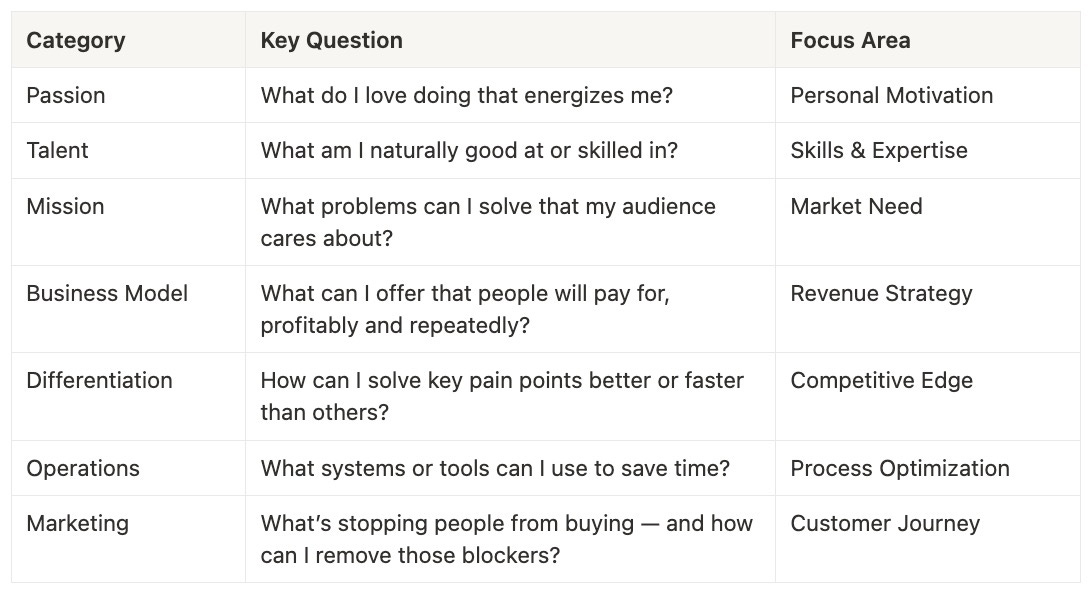

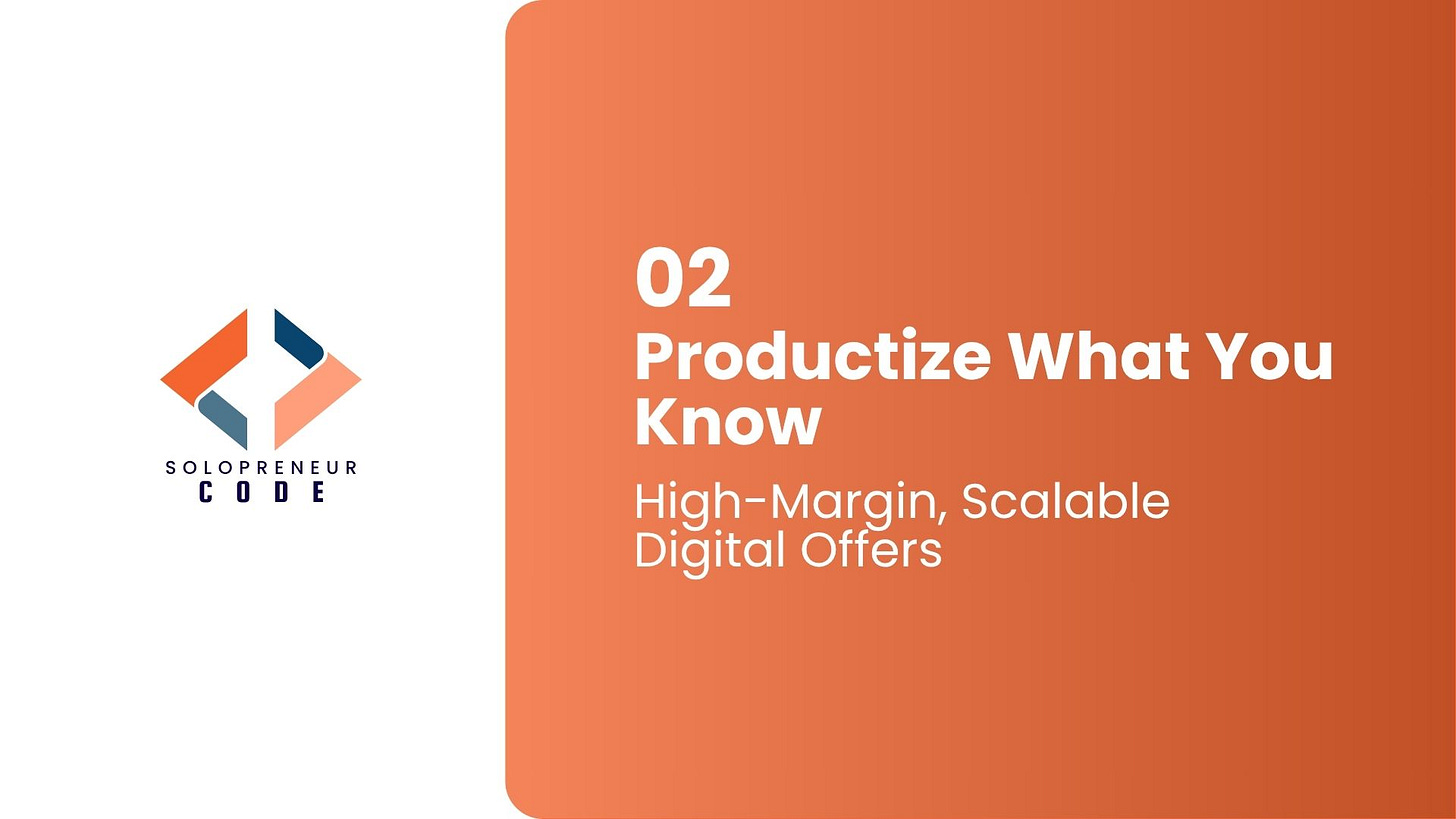



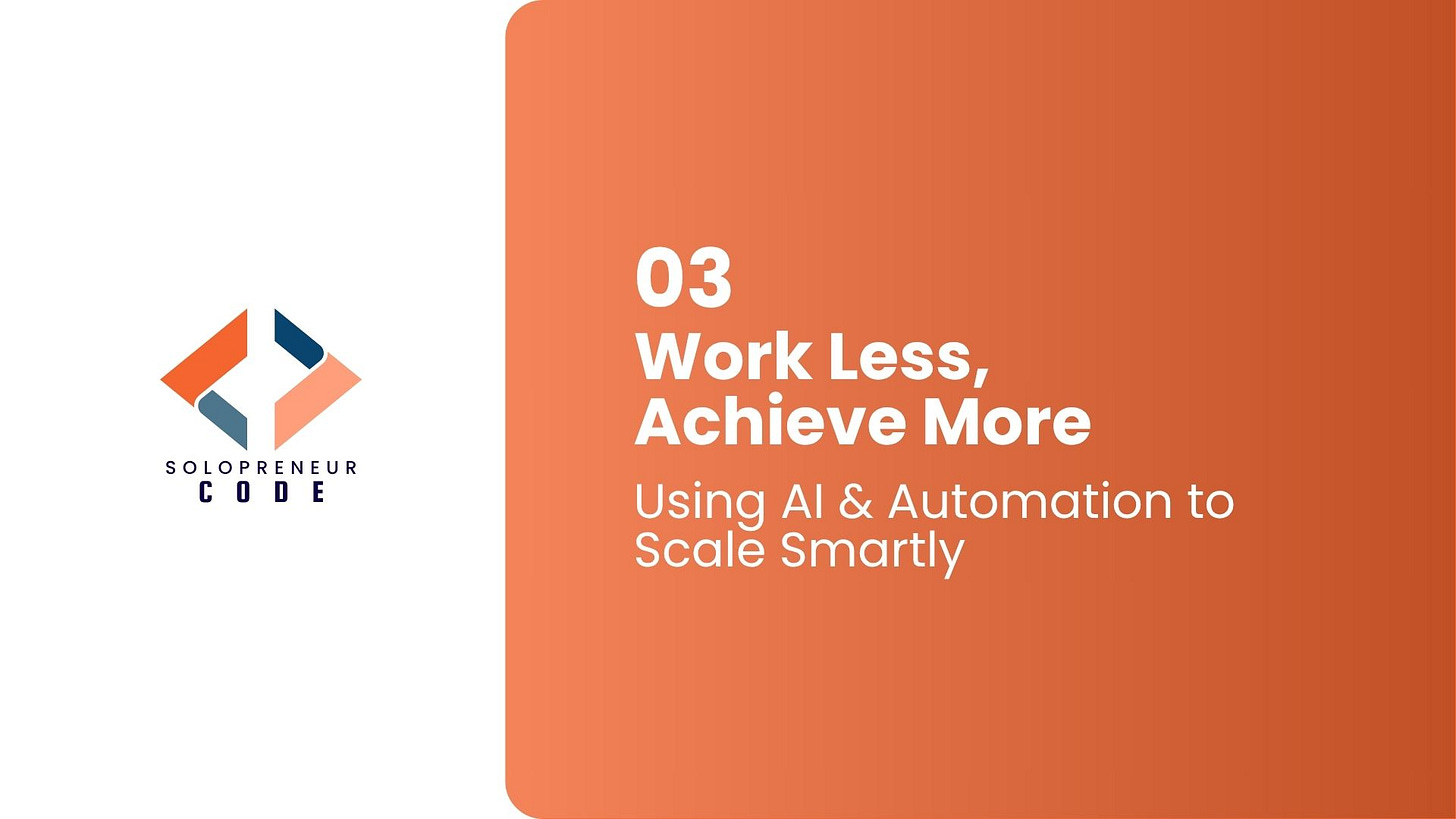




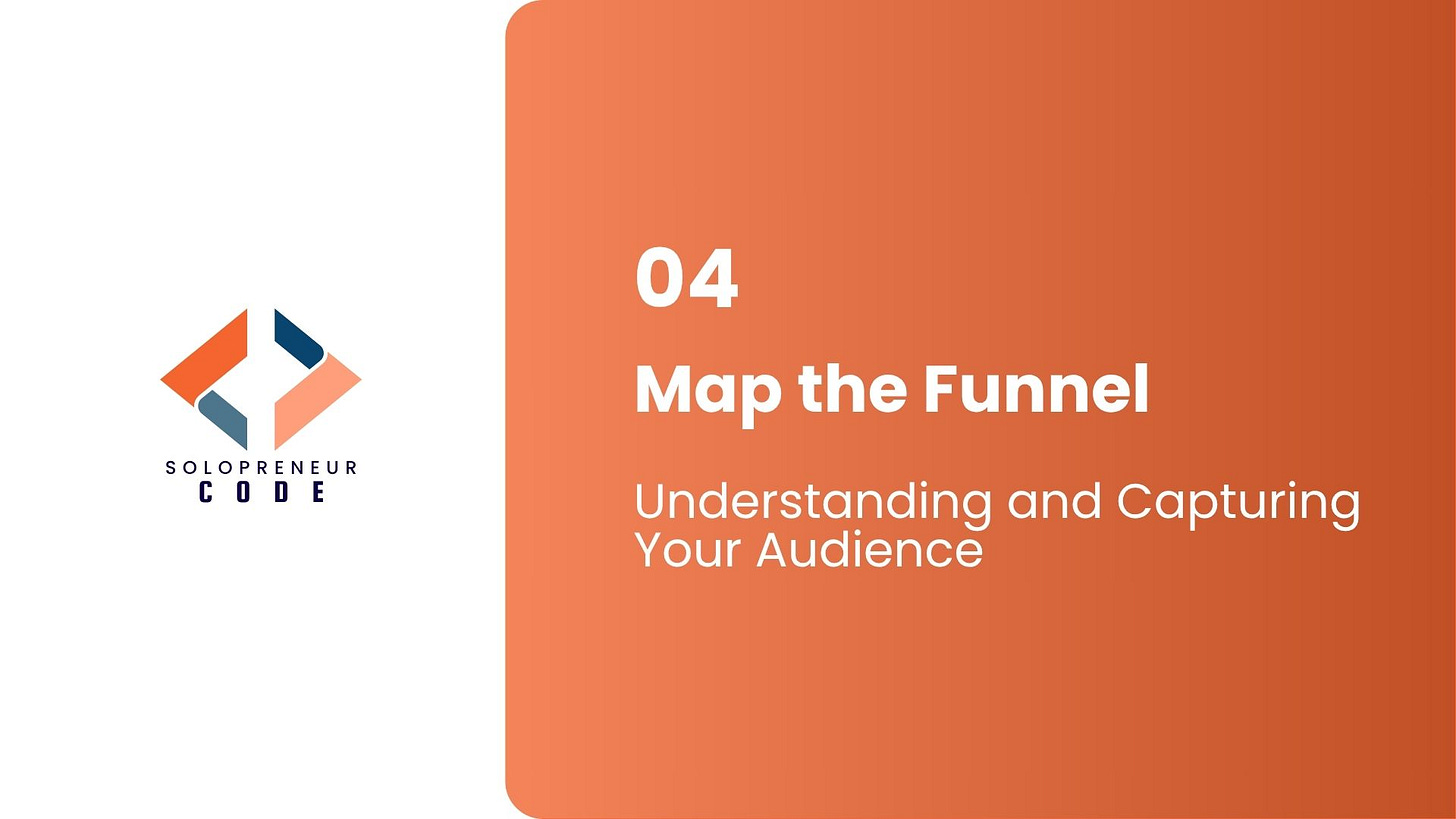


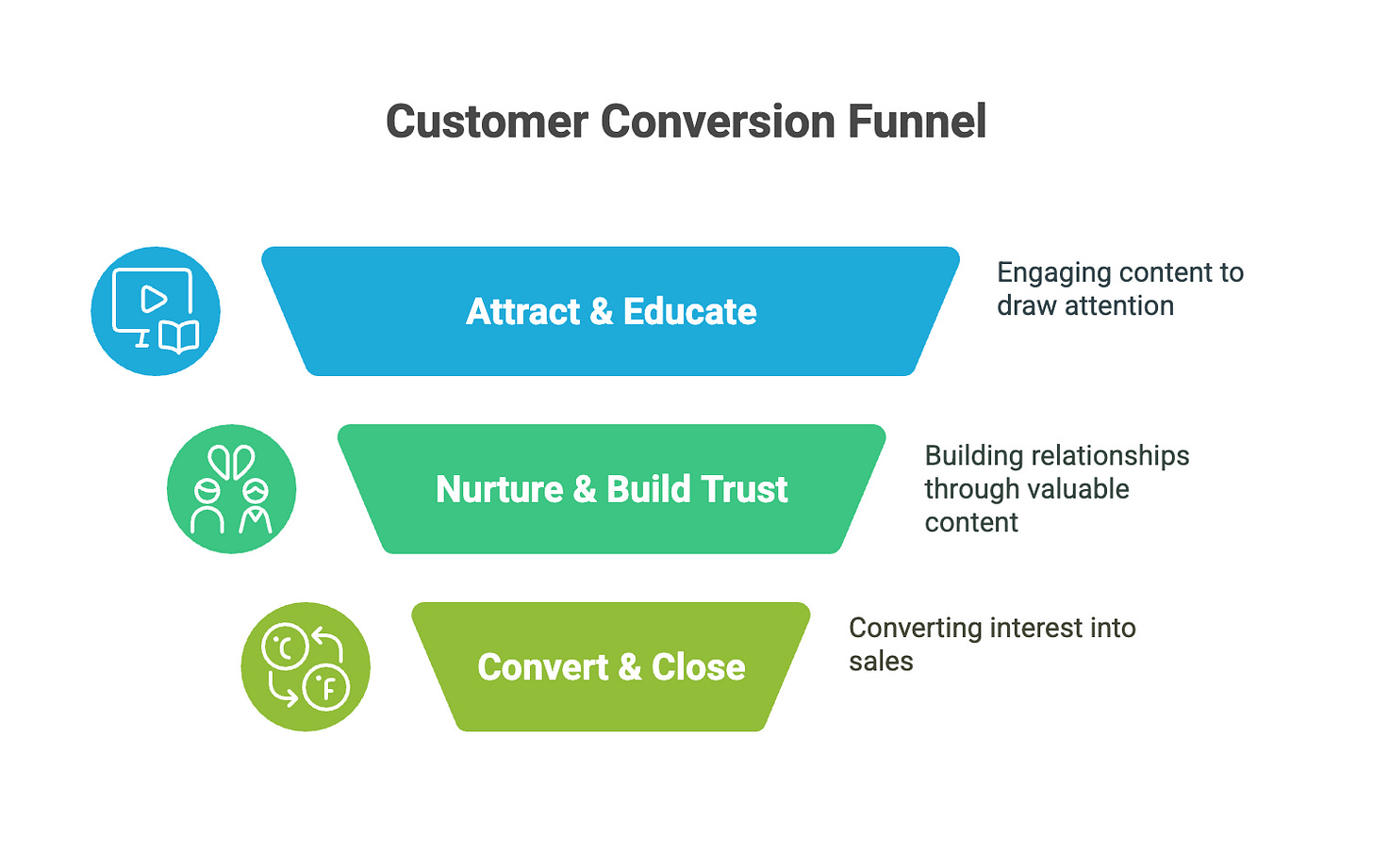


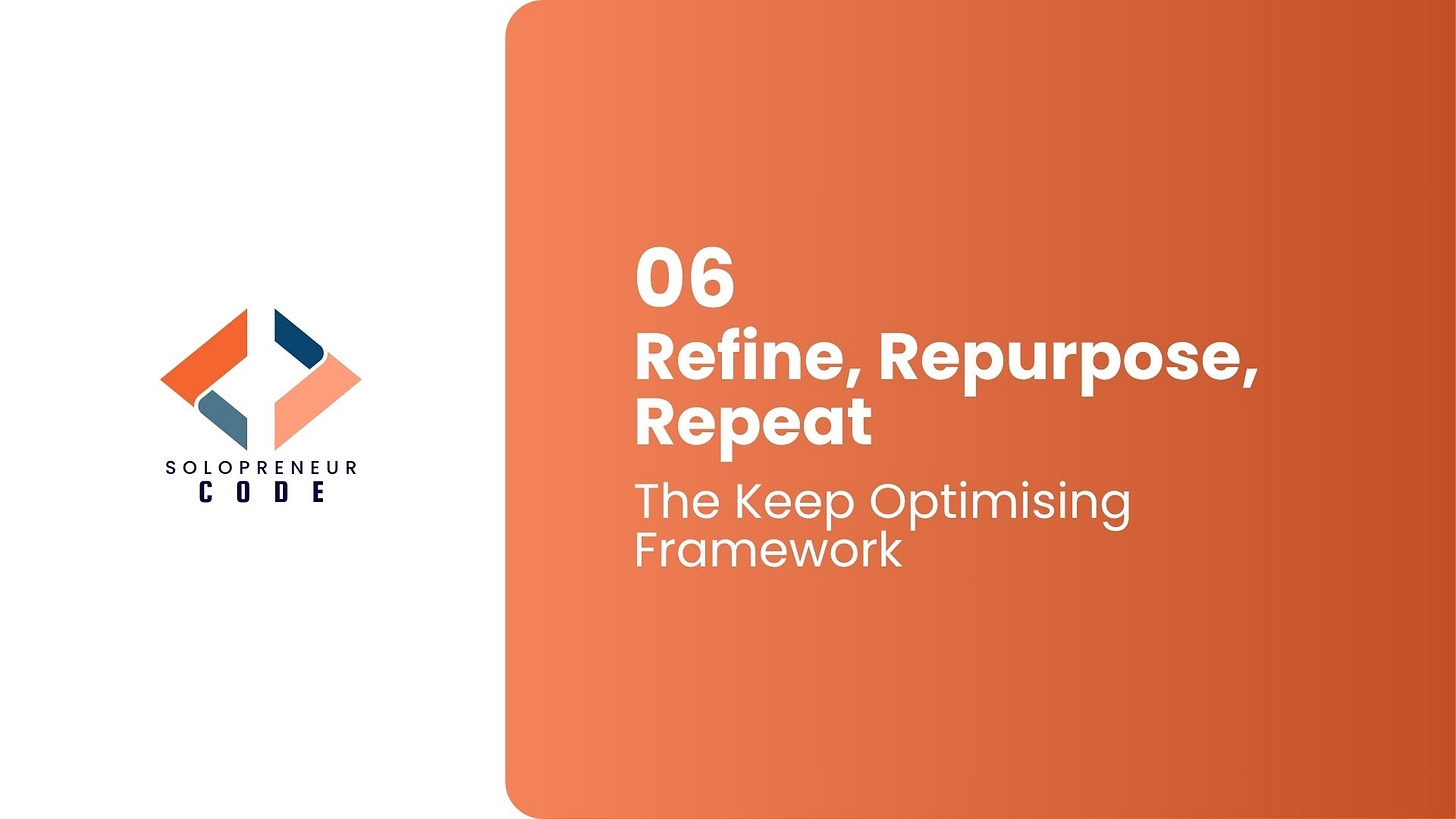



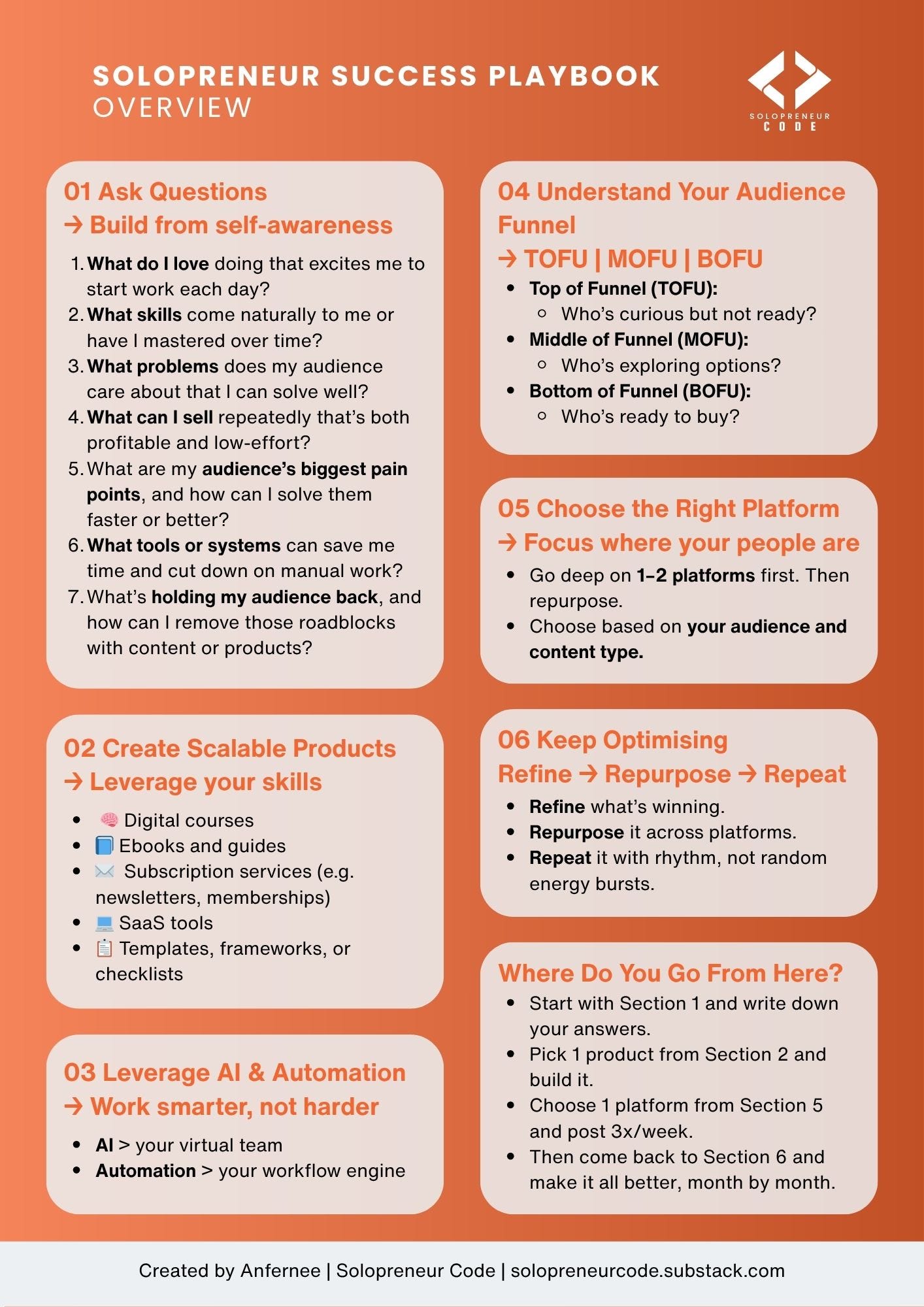

That's my favorite post from you! It's packed with value, thank you Anfernee!
This is a great resource! Very practical and useful. Thanks for sharing.